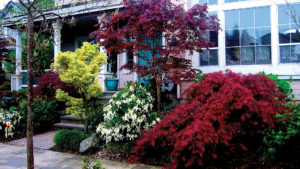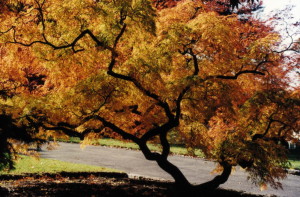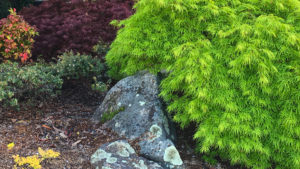Details Landscape Art, a local landscape design-build contractor, uses Japanese maples frequently in many of their gardens. And planting Japanese maples is not difficult.

Here in the Bay area of Northern California, Japanese maples are an ideal choice in almost any garden situation, for a few reasons. First of all, they are relatively small trees, and are therefore useful in the smaller fenced-in yards prevalent in our area. Second, they are a great patio tree and work well in median strips, since the roots are not invasive and will not lift concrete surfaces.
Third, they are gorgeous. There are hundreds of varieties available ranging from low shrubby forms to upright varieties in a range of colors from green to shades of deep red.
When planting Japanese maples, there are a few considerations. First is sun exposure. Choosing the right maple for a particular location requires determining if the tree will be in afternoon sun or shade. As a general rule, the green leafed varieties

can take full sun very well. The variegated leaf varieties definitely need some shade, especially in the afternoon when the sun is the hottest. The red leafed forms need some shade, but to show their beautiful red coloration, they do need some sun for at least part of the day.
Second is wind exposure. The fine leafed dissectums need protection from the wind or else they will get leaf burn.
The third consideration is soil type. Soils range from sandy at one extreme to clay at the other extreme. The sandier the soil, the deeper the tree can be planted. In heavy clay soils, it is wise to plant the tree so that the crown of the tree is three or four inches above grade, and then mound the soil or bark up to (but not over) the crown. This allows for faster drainage of water away from the tree.
The planting hole should be wider than the root ball, and certainly no deeper. Japanese maples require moderate but regular watering. Excessive watering or planting too deep will result in root rot and certain death. Mulching over the root ball provides winter protection, and helps keep the surface roots from drying out. All Japanese maple cultivars can stand winter freezing down to zero degrees, but the roots must be protected from deep freezing temperatures. So rainfall that penetrates several inches and then freezes can harm the shallower roots.

Japanese maples do not require much fertilizer. Normal garden soils, and occasional supplemental fertilizer should be sufficient. Sandy soils without nutrients may require some additional fertilizer.
Japanese maples benefit from annual pruning. Although shaping the tree is desirable, the most important pruning technique is a process of thinning. Obviously, dead branches should be removed. And where branches are growing parallel and close to one another should be thinned. We also recommend removing crossing branches. Thinning a tree gives it air space, allows wind to blow through the branches, and makes for a more appealing shape. One of the attractions of a well-pruned Japanese maple is the irregular ‘gnarly’ branching structure.
Planting Japanese maples is both an art and a science.
